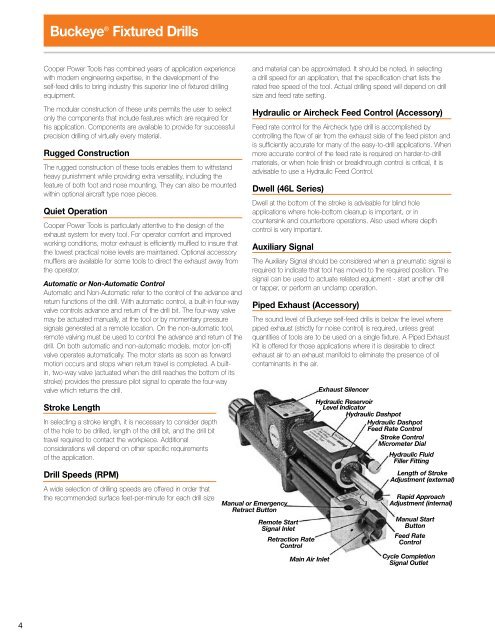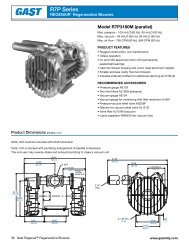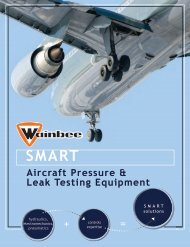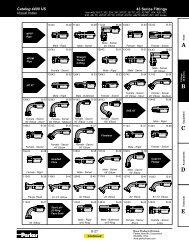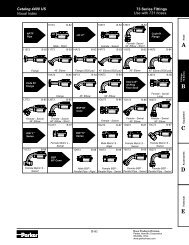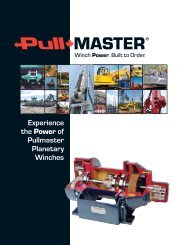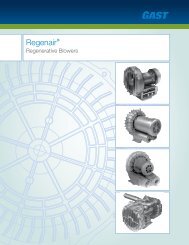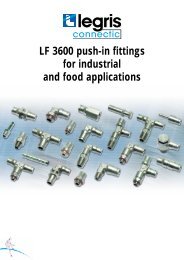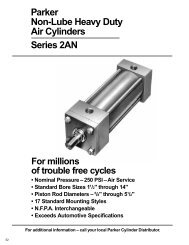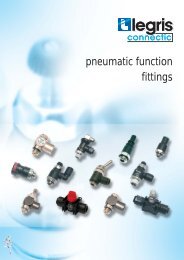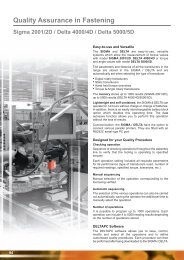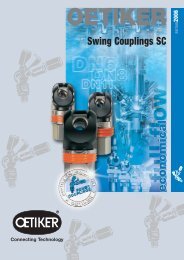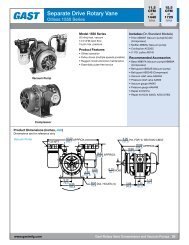Pneumatic Fixtured Drills - Douwes International B.V.
Pneumatic Fixtured Drills - Douwes International B.V.
Pneumatic Fixtured Drills - Douwes International B.V.
You also want an ePaper? Increase the reach of your titles
YUMPU automatically turns print PDFs into web optimized ePapers that Google loves.
Buckeye ® <strong>Fixtured</strong> <strong>Drills</strong><br />
Cooper Power Tools has combined years of application experience<br />
with modern engineering expertise, in the development of the<br />
self-feed drills to bring industry this superior line of fixtured drilling<br />
equipment.<br />
The modular construction of these units permits the user to select<br />
only the components that include features which are required for<br />
his application. Components are available to provide for successful<br />
precision drilling of virtually every material.<br />
Rugged Construction<br />
The rugged construction of these tools enables them to withstand<br />
heavy punishment while providing extra versatility, including the<br />
feature of both foot and nose mounting. They can also be mounted<br />
within optional aircraft type nose pieces.<br />
Quiet Operation<br />
Cooper Power Tools is particularly attentive to the design of the<br />
exhaust system for every tool. For operator comfort and improved<br />
working conditions, motor exhaust is efficiently muffled to insure that<br />
the lowest practical noise levels are maintained. Optional accessory<br />
mufflers are available for some tools to direct the exhaust away from<br />
the operator.<br />
Automatic or Non-Automatic Control<br />
Automatic and Non-Automatic refer to the control of the advance and<br />
return functions of the drill. With automatic control, a built-in four-way<br />
valve controls advance and return of the drill bit. The four-way valve<br />
may be actuated manually, at the tool or by momentary pressure<br />
signals generated at a remote location. On the non-automatic tool,<br />
remote valving must be used to control the advance and return of the<br />
drill. On both automatic and non-automatic models, motor (on-off)<br />
valve operates automatically. The motor starts as soon as forward<br />
motion occurs and stops when return travel is completed. A builtin,<br />
two-way valve (actuated when the drill reaches the bottom of its<br />
stroke) provides the pressure pilot signal to operate the four-way<br />
valve which returns the drill.<br />
Stroke Length<br />
In selecting a stroke length, it is necessary to consider depth<br />
of the hole to be drilled, length of the drill bit, and the drill bit<br />
travel required to contact the workpiece. Additional<br />
considerations will depend on other specific requirements<br />
of the application.<br />
Drill Speeds (RPM)<br />
A wide selection of drilling speeds are offered in order that<br />
the recommended surface feet-per-minute for each drill size<br />
and material can be approximated. It should be noted, in selecting<br />
a drill speed for an application, that the specification chart lists the<br />
rated free speed of the tool. Actual drilling speed will depend on drill<br />
size and feed rate setting.<br />
Hydraulic or Aircheck Feed Control (Accessory)<br />
Feed rate control for the Aircheck type drill is accomplished by<br />
controlling the flow of air from the exhaust side of the feed piston and<br />
is sufficiently accurate for many of the easy-to-drill applications. When<br />
more accurate control of the feed rate is required on harder-to-drill<br />
materials, or when hole finish or breakthrough control is critical, it is<br />
advisable to use a Hydraulic Feed Control.<br />
Dwell (46L Series)<br />
Dwell at the bottom of the stroke is advisable for blind hole<br />
applications where hole-bottom cleanup is important, or in<br />
countersink and counterbore operations. Also used where depth<br />
control is very important.<br />
Auxiliary Signal<br />
The Auxiliary Signal should be considered when a pneumatic signal is<br />
required to indicate that tool has moved to the required position. The<br />
signal can be used to actuate related equipment - start another drill<br />
or tapper, or perform an unclamp operation.<br />
Piped Exhaust (Accessory)<br />
The sound level of Buckeye self-feed drills is below the level where<br />
piped exhaust (strictly for noise control) is required, unless great<br />
quantities of tools are to be used on a single fixture. A Piped Exhaust<br />
Kit is offered for those applications where it is desirable to direct<br />
exhaust air to an exhaust manifold to eliminate the presence of oil<br />
contaminants in the air.<br />
Manual or Emergency<br />
Retract Button<br />
Remote Start<br />
Signal Inlet<br />
Retraction Rate<br />
Control<br />
Main Air Inlet<br />
Exhaust Silencer<br />
Hydraulic Reservoir<br />
Level Indicator<br />
Hydraulic Dashpot<br />
Hydraulic Dashpot<br />
Feed Rate Control<br />
Stroke Control<br />
Micrometer Dial<br />
Hydraulic Fluid<br />
Filler Fitting<br />
Length of Stroke<br />
Adjustment (external)<br />
Rapid Approach<br />
Adjustment (internal)<br />
Manual Start<br />
Button<br />
Feed Rate<br />
Control<br />
Cycle Completion<br />
Signal Outlet


